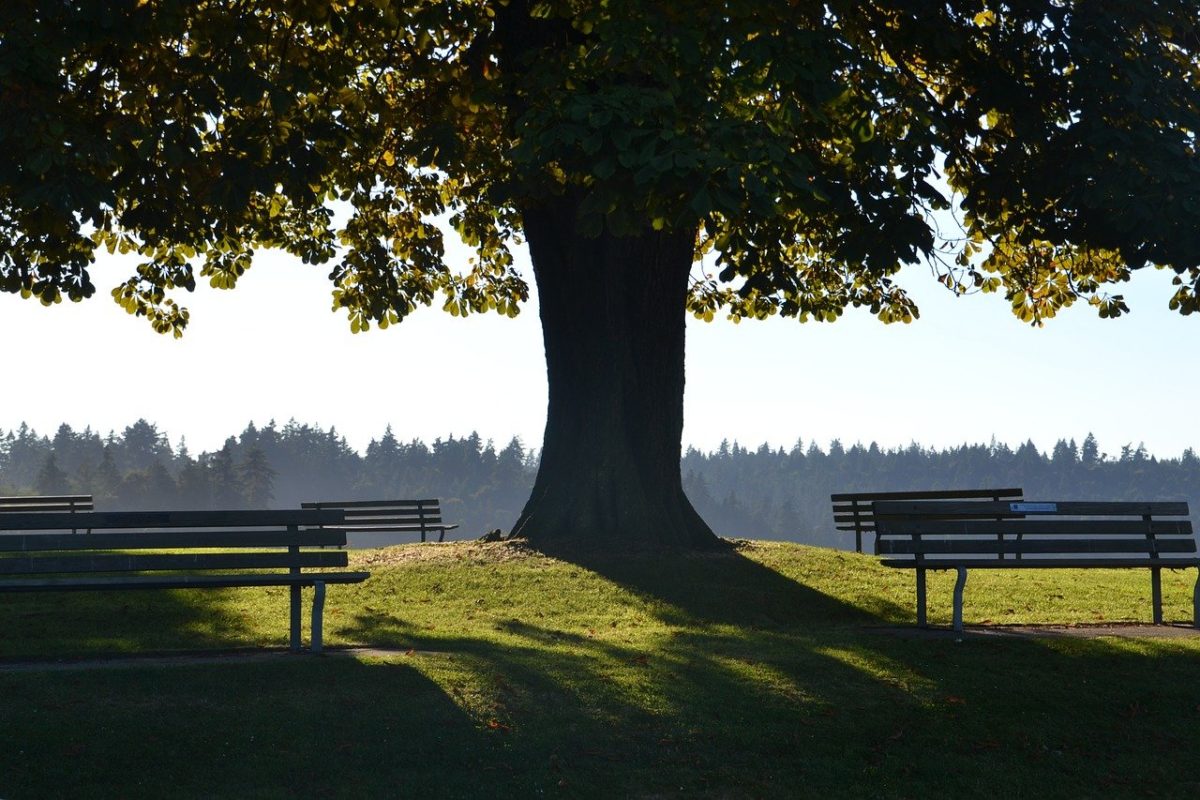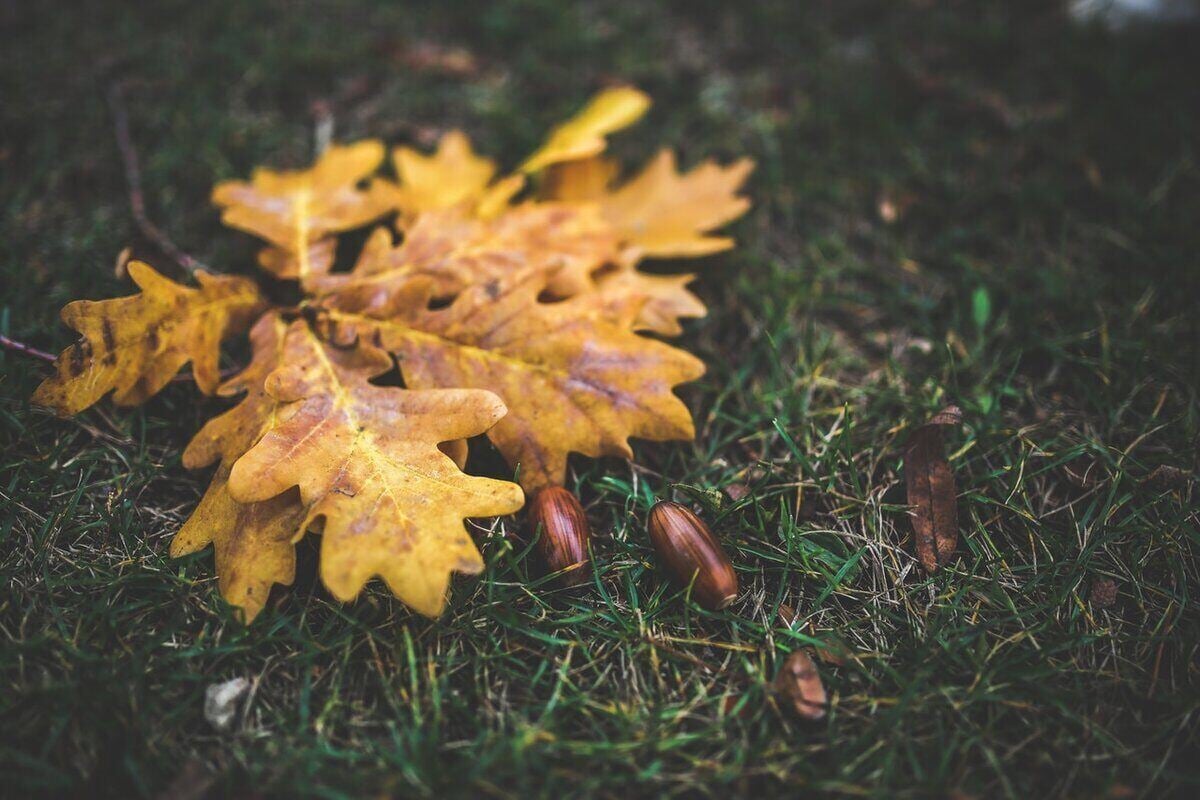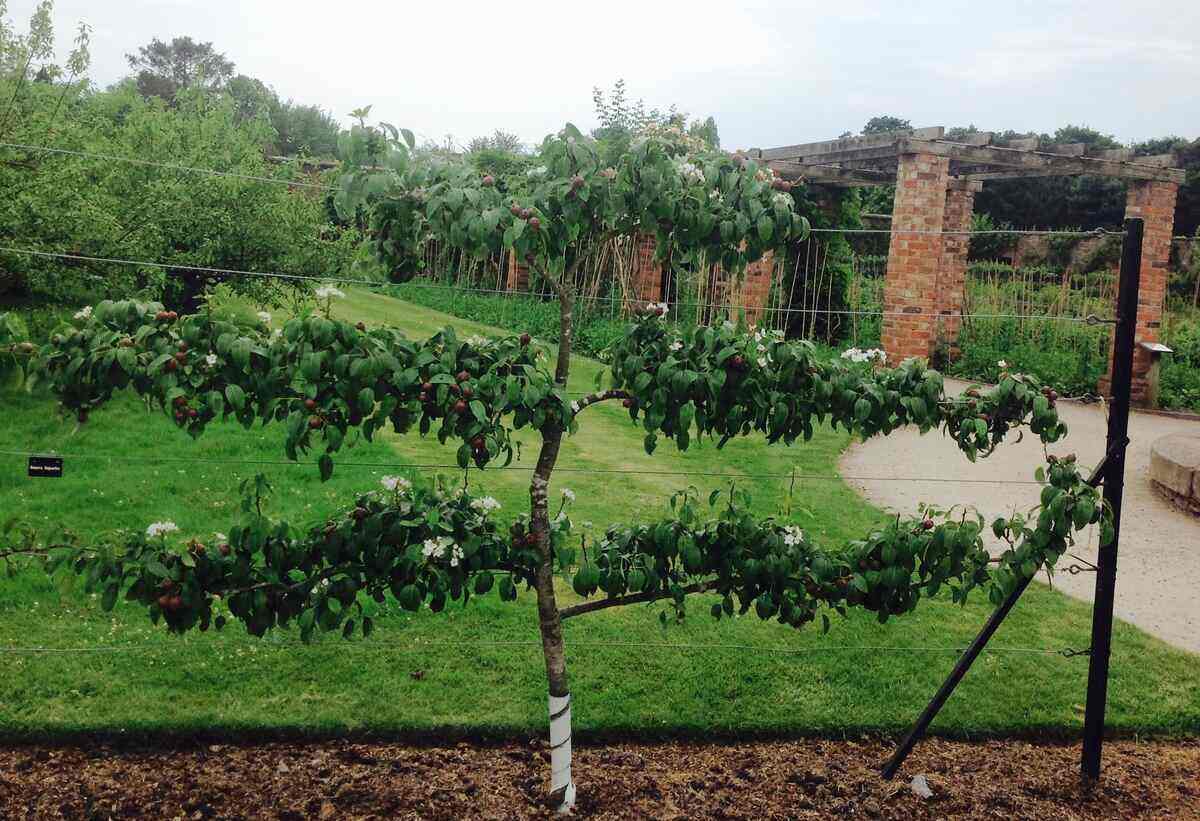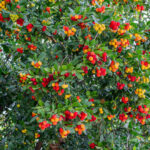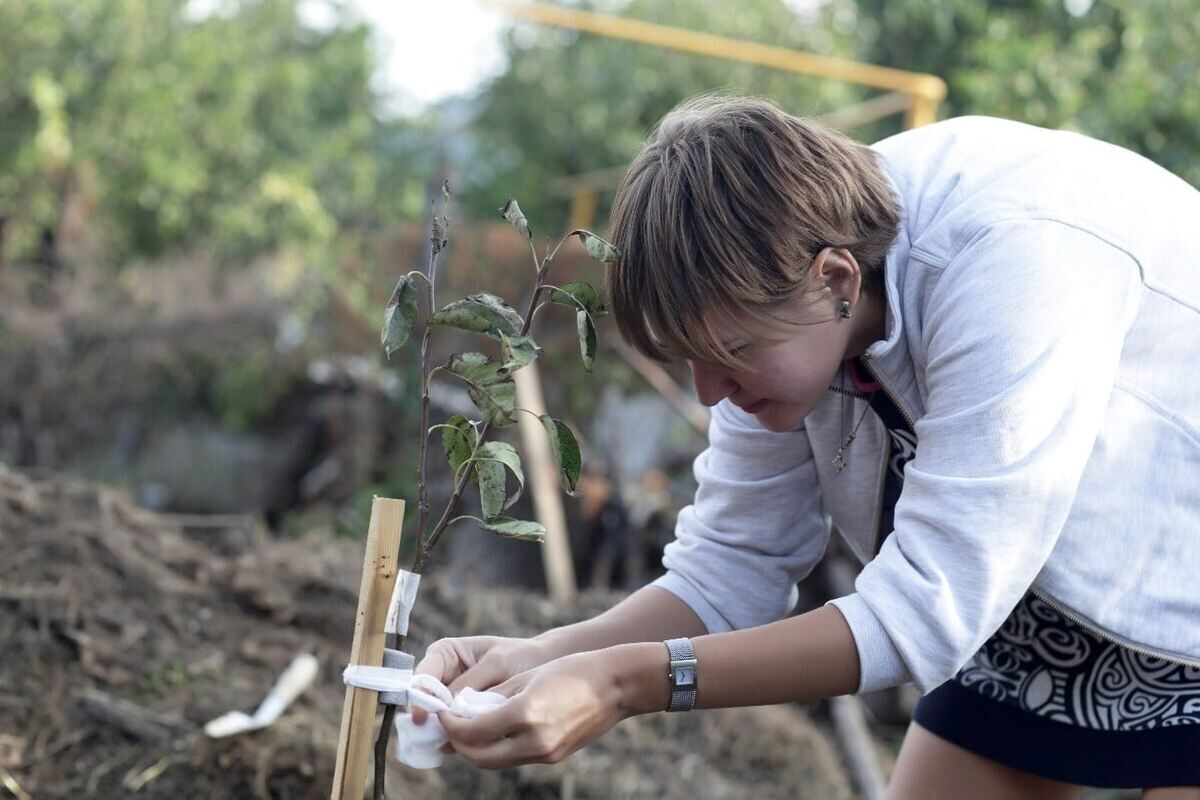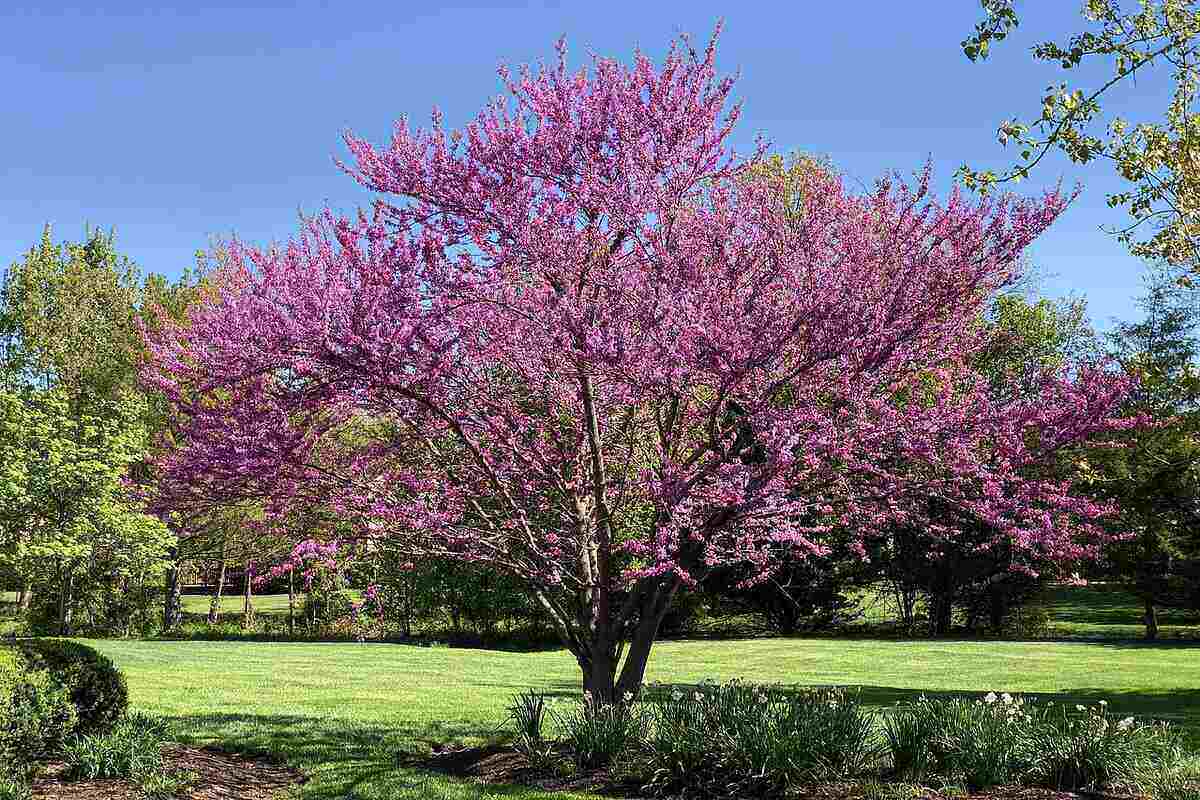
Covered in a dense tree canopy, Atlanta proudly wears its “City in a forest” name. Almost 60% of single-family and 40% of multi-family residential properties in the city are tree-covered. Tree heaven indeed, giving precious shade during summer heat and a spectacular rainbow show in the autumn.
What trees do homeowners plant in their A-town gardens? The list is enormous. If you just moved in or you’re reshaping a treeless yard, this article can help. We pulled out the 14 best trees to plant in Atlanta, including both fruit and flowering trees.
1. Southern Live Oak
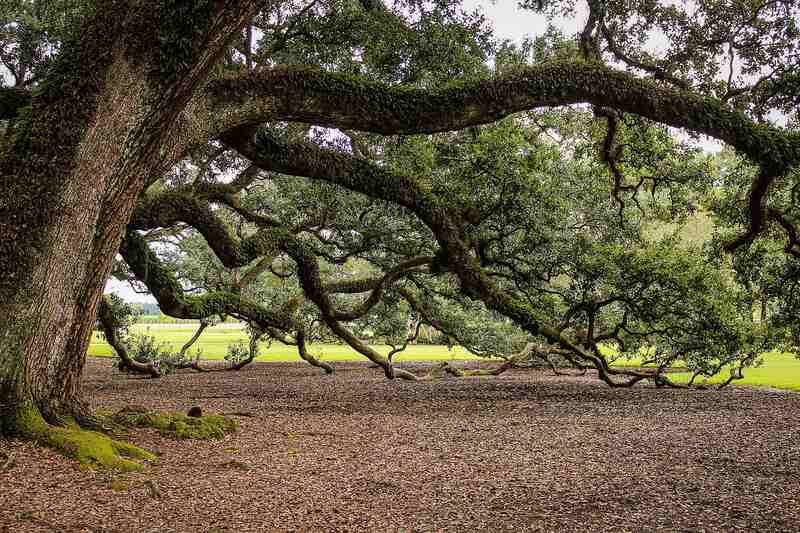
The live oak is a majestic tree designated as the official Georgia state tree in 1937. Part of the red oak family, it’s fast-growing, with massive branches and a broad-spreading, low crown.
While not a true evergreen, this fantastic tree keeps its leaves until spring, when the new ones emerge. It creates a wonderfully shaded space in your yard where you can:
- Spread ornamental mulch.
- Install plants that don’t need much sun, like Autumn fern, variegated Solomon’s seal, hosta, or mondo grass.
- Put in a coffee serving area.
The Southern Live Oak is more suitable for the larger yards of Atlanta. With limited outdoor space, consider smaller cultivars of oak trees such as the Highrise or Post Oak. All cultivars are deciduous trees and lose their leaves in late fall.
- Botanical name: Quercus virginiana
- Other common names: Bay live oak, plateau oak
- Size at maturity: Grows 60 to 100 feet tall and 50 to 60 feet wide
- Growth rate: Moderate grower (two feet in height and one inch in trunk diameter each year)
- Lifespan: 60 to 75 years (up to 250 to 500 years in good growing conditions)
- Soil and water requirements: Grows in dry, sandy, or clay loam soil; tolerates drought and poor soils
- Light requirements: Partial shade or full sun
- USDA hardiness zone: Hardy in zones 6 to 8
2. White Dogwood
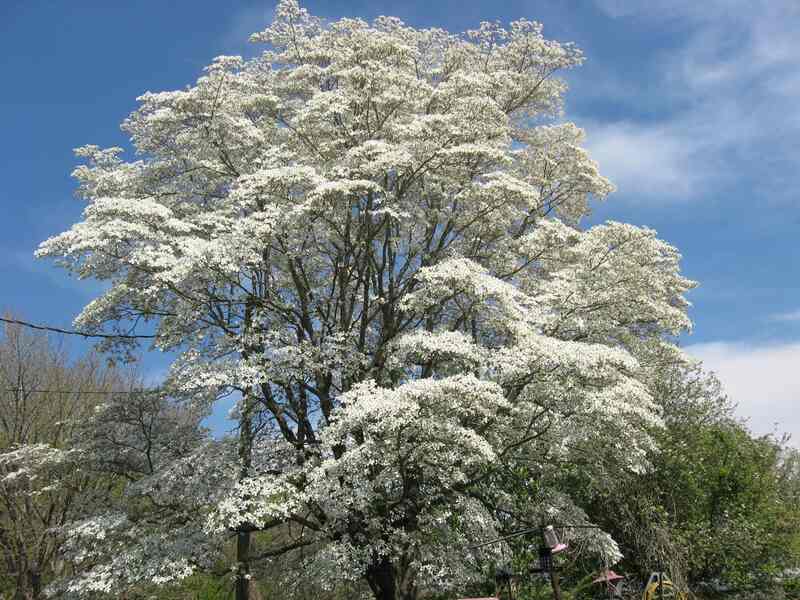
Also known as The Dogwood City, Atlanta treasures this beautiful flowering tree, celebrated in festivals, parks, and gardens. With their awesome white or pink blossoms, white dogwoods are the uncontested star at Atlanta’s Dogwood Festival, held yearly for over 8 decades.
The dogwood has amazing green summer leaves that become scarlet red during fall, and the dark bark is impressive during winter. This native tree might be one of the most spectacular flowering trees you can choose for your yard.
- Botanical name: Cornus florida
- Other common names: American dogwood, Indian arrowwood, cornelian tree, white cornel, false boxwood
- Size at maturity: Grows 15 to 25 feet tall and 20 to 25 feet wide
- Growth rate: Medium rate, grows 1 to 2 feet per year
- Lifespan: About 80 years
- Soil and water requirements: Enjoys well-drained, fertile, moist, acidic soils (a pH of 6 to 7)
- Light requirements: Some afternoon shade, but good morning sun
- USDA hardiness zone: Hardy to zones 5 to 9
3. River Birch
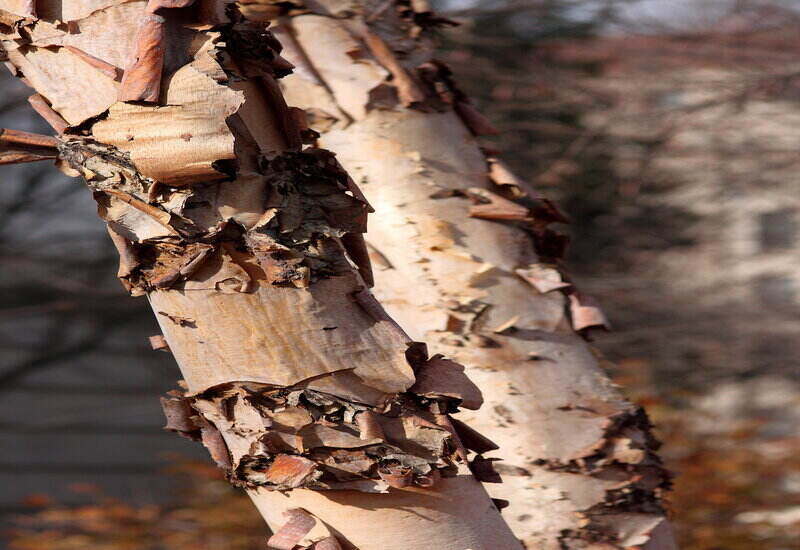
The river birch has an elegant, slim, tall silhouette with silver-gray to cinnamon-brown bark. It’s an ever-changing beauty, peeling its two-toned bark year-round. Come fall, its delicate leaves turn a showy yellow that lightens up your garden.
It’s a fast grower with valuable visual details, excellent for landscaping projects. The river birch’s love for moist soil means you must water it during dry weeks to keep it healthy.
- Botanical name: Betula nigra
- Other common names: Black birch, red birch, river birch, water birch
- Size at maturity: Grows 40 to 70 feet tall and up to 40 feet wide
- Growth rate: Medium to fast rate (1 to more than 2 feet a year)
- Lifespan: 75 to 100 years
- Soil and water requirements: Grows well in acidic, loamy, sandy, and clay soils. If not planted in wet soil, deeply water it for two to three hours weekly. It thrives in damp soil and visibly suffers during drought.
- USDA hardiness zone: Hardy to zones 6 to 8
4. Trident Maple
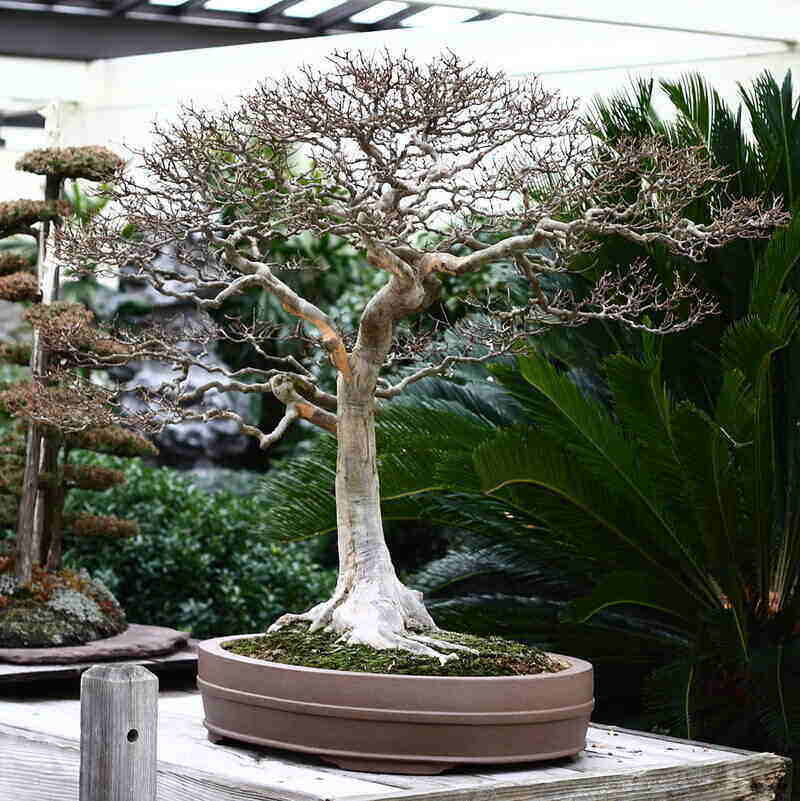
A good choice for medium-sized gardens in the Peach State, the trident maple is full of color and texture from top to bottom. This maple tree grows a rounded crown with dark-green leaves that turn bright yellow to deep red in the fall.
Its bark exfoliates year-round and enriches in tones as the tree ages, showing beautiful silver, orange, and brown details. The trident maple is often included in modern landscapes and can be pruned to grow as a single-trunked or multi-trunked tree. Under this tree’s crown, you can safely plant:
- Tulips
- Daffodils
- Snowdrops
- Grape hyacinths
These flowers will receive enough light in the spring to thrive and flower.
- Botanical name: Acer buergerianum
- Other common names: Three-toothed maple
- Size at maturity: Grows 25 to 35 feet tall and 15 to 25 feet wide
- Growth rate: Slow to moderate (less than 1 foot to 2 feet a year)
- Life span: About 100 years
- Soil and water requirements: Thrives in moist, well-drained soil, acidic to neutral; requires weekly watering when young and during dry spells after the first two years
- Light requirements: Full sun or partial shade
- USDA hardiness zone: Adapted to zones 5 to 9
5. Southern Magnolia
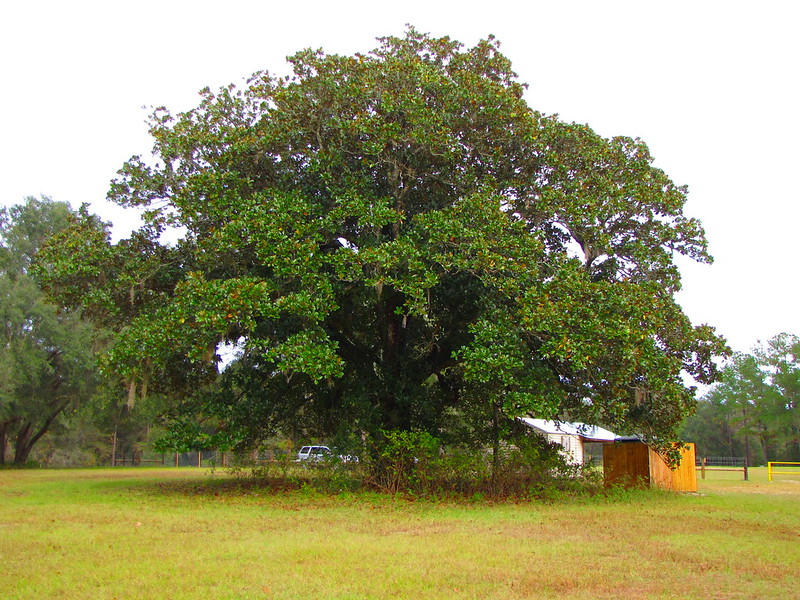
With glossy, deep-green, large leaves and huge white flowers, Southern Magnolia is an aristocratic evergreen tree fit for passionate gardeners.
Magnolia flowers have a sweet, soothing, fresh fragrance valued in aromatherapy. You can enjoy its unique scent by making it part of your relaxation area. For lovely companions to plant around the tree, choose species that tolerate shade, such as:
- Camelias
- Daffodils
- Dwarf irises
- Calla lilies
- Elephant years
Consider varieties that bloom with white or light-colored flowers. They will shine in the shade. Turfgrass might not grow as well under this tree, but you can create a lush cover of ferns and hostas.
- Botanical name: Magnolia grandiflora
- Other common names: Sweet magnolia, laurel magnolia, evergreen magnolia, large-flower magnolia, big laurel
- Size at maturity: Grows up to 80 feet tall and 50 feet wide; consider dwarf cultivars like Little Gem (up to 25-30 feet tall) for a small yard.
- Growth rate: Slow to medium (less than 1 foot to 2 feet a year)
- Lifespan: 80 to 120 years
- Soil and water requirements: Thrives in moist, well-drained, acidic to slightly alkaline soils; tolerates wet/dry fluctuations.
- Light requirements: Sun or shade
- USDA hardiness zone: Adapted to zones 6 to 10
6. Crape Myrtle
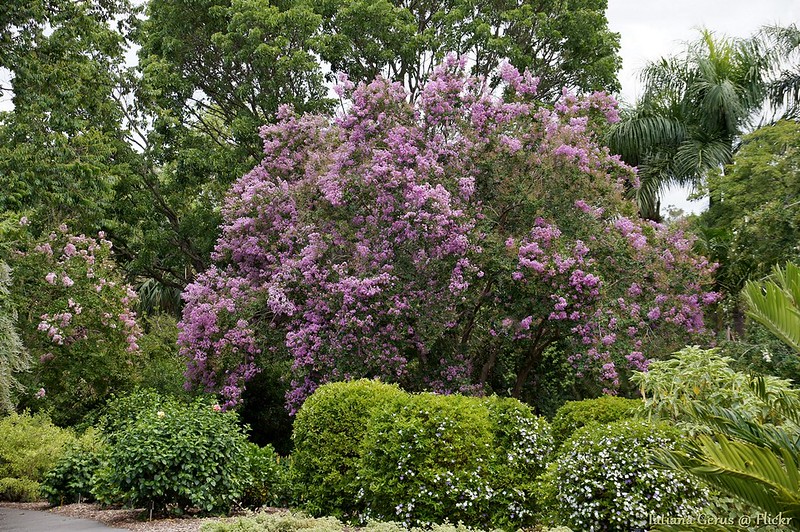
Looking for a low-maintenance landscape tree with vibrant, colorful flowers? Crape myrtle is a perfect choice. It has good drought resistance and is relatively free of diseases and pests.
Depending on the cultivar, you can grow crape myrtle as a tree or shrub. Its crinkled crepe paper-like flowers bloom in dense clusters ranging from red and pink to lavender and white. They give it the “Lilac of the South” nickname. Both trees and shrubs look fantastic, surrounded by: Columbines, Lily of the Valley, Hibiscus, Verbena, Daffodils, and Chrysanthemums.
- Botanical name: Lagerstroemia spp.
- Other common names: Crepe myrtle
- Size at maturity: Grows 3 to 20 feet tall and 6 to 15 feet wide
- Growth rate: Fast (more than 2 feet a year)
- Lifespan: 25 to 100 years
- Soil and water requirements: Grows in moist, well-drained soil, slightly alkaline to acidic; tolerates sandy or clay soils.
- USDA hardiness zone: Adapted to zones 7 to 10
7. American Redbud
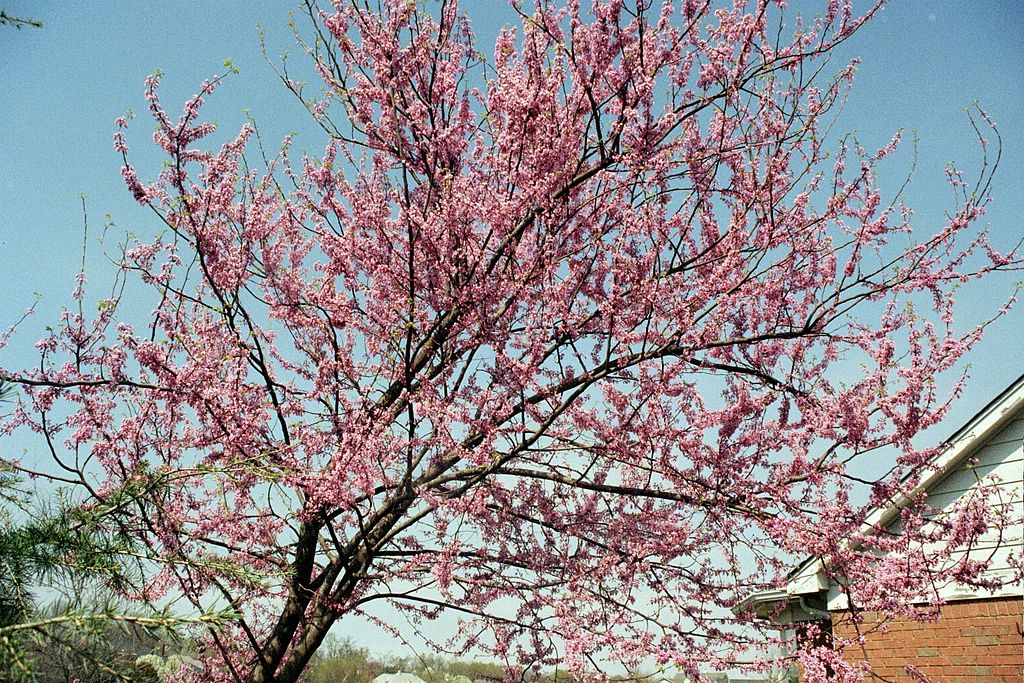
The American redbud is a small, flat-topped tree that brings color to your garden in late winter and early spring. It opens thousands of tiny rosy-pink to reddish-purple flowers at a time when only daffodils dare to bloom.
The redbud’s trunk divides close to the ground, covered in a canopy of delicate heart-shaped leaves with a delightful fall color. These small trees are an excellent pollen source for bees, butterflies, and hummingbirds early in the year. You also find them among the top drought-tolerant trees in the U.S.
- Botanical name: Cercis canadensis
- Other common names: Eastern redbud, Judas tree
- Size at maturity: Grows 20 to 30 feet tall and 25 to 35 feet wide
- Growth rate: Medium (12 to 24 inches per year)
- Lifespan: 50 to 70 years
- Soil and water requirements: Tolerates various soils: acidic, alkaline, loamy, moist, rich, sandy, and clay; very drought-tolerant
- Light requirements: Full sun to part shade
- USDA hardiness zone: Adapted to zones 4 to 9
8. Peach Trees
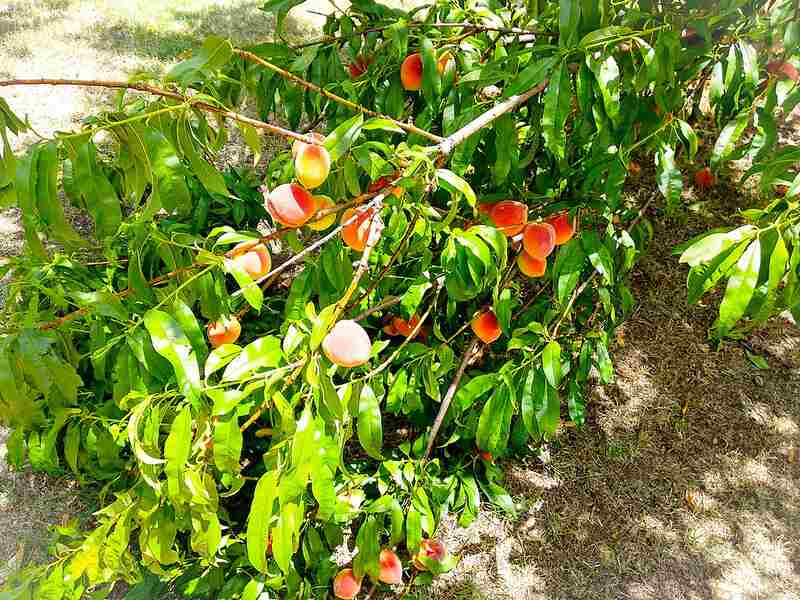
Living in the Peach State makes picking fresh, ripe fruits from your peach tree during summer seem only natural. The Atlanta climate helps these small trees grow tasty, juicy fruits with a wonderful aroma.
They need 2 to 4 years for the first fruits to appear, but after that, you’ll enjoy them yearly in their growing season, from June through August. Fruit trees are more attractive to pests and vulnerable to some diseases. If you plan to grow peach trees in A-Town, contact an arborist early on to learn all the treatments you need to know about.
- Botanical name: Prunus persica
- Other common names: No alternate names
- Size at maturity: Grows up 25 feet in height with a 25-foot spread when left unpruned
- Growth rate: 12 to 24 inches every year
- Lifespan: 10 to 20 years
- Soil and water requirements: Peach trees thrive in well-drained, loamy, slightly acidic, neutral soils. Young trees need watering during the summer, with 35 to 40 gallons of water daily.
- Light requirements: Full sun
- USDA hardiness zone: Adapted to zones 4 to 9
9. Pear Trees
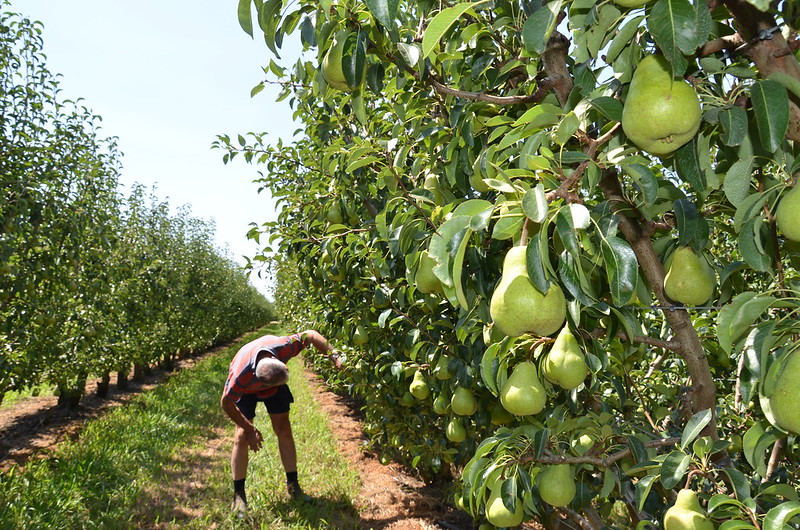
A sunny garden in the Big Peach is also suitable for pear trees. You can enjoy sweet, juicy pears in just a few years with some care, proper maintenance, and treatment.
Many pear varieties suitable for planting in Georgia are available in local nurseries. Some of the most popular species for the Metro Atlanta area are:
- Bartlet
- Kiefer
- Carrick
- White
- Spalding.
The University of Georgia recommends choosing self-pollinators if you want only one tree. Also, give special attention to the right picking time for ripe, sweet, long-lasting fruits.
- Botanical name: Pyrus communis (European pear), Pyrus pyrifolia (Asian pear)
- Other common names: No alternate names
- Size at maturity: Grows up to 35 feet tall and 20 feet wide (if unpruned)
- Growth rate: Fast, more than 2 feet every year
- Lifespan: Over 50 years (dwarf and semi-dwarf varieties live less, up to 25 years)
- Soil and water requirements: Thrives and gives the best yields in loamy, sandy soils; tolerates average soils if well-drained and with a pH ranging from 6 to 7; on the clay Atlanta soil, water once a week
- Light requirements: Full sun for good fruit production
- USDA hardiness zone: Hardy to zones 4 to 8
10. Bald Cypress

Bald cypress is a lovely conifer to add to your landscape. Its canopy grows in a pyramidal shape with soft, feather-like leaves. Starting as yellow-green in early spring, the bald cypress foliage shows a deep fall color, mixing reddish with orangish-brown shades.
It is also a shade tree with a spreading crown dense enough to block sunlight. If you want to plant under its canopy or nearby, consider species that love acidic soils and shade, such as columbine, comfrey, daffodils, dandelion, grape hyacinth, hostas, and lady fern.
- Botanical name: Taxodium distichum
- Other common names: Swamp cypress, white cypress, tidewater red cypress, gulf cypress
- Size at maturity: Grows 50 to 70 feet tall and around 25 feet wide
- Growth rate: Medium, between 1 and 2 feet per year
- Lifespan: Around 600 years
- Soil and water requirements: Bald cypress prefers acidic soil. It grows in loamy, sandy, silty loam, and clay soils and adapts well enough to wet or dry conditions. Still, it’s native to swamp areas with wet soil, so ensure you give it enough moisture.
- Light requirements: Full sun
- USDA hardiness zone: Grows in zones 4 to 10
11. Japanese Maple
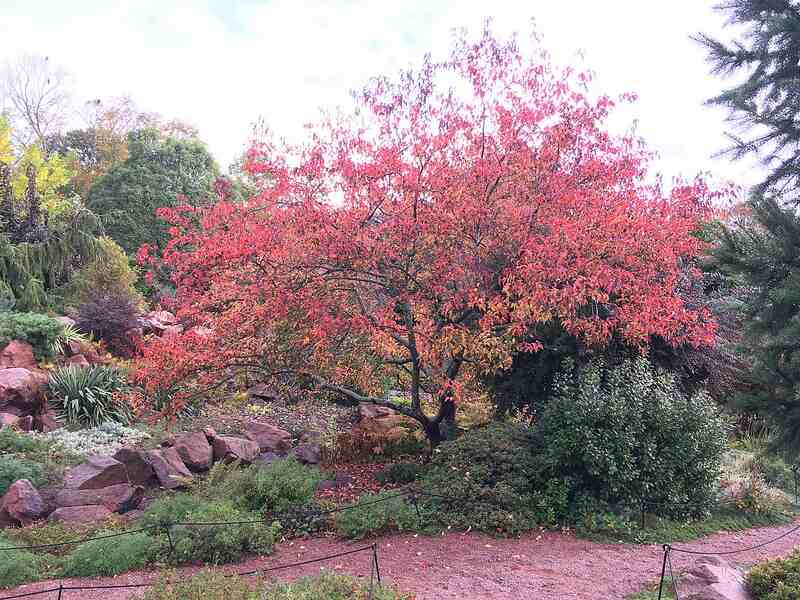
Japanese maples are legendary for their beauty, and Atlanta’s climate is blessed with weather that suits them well. Planting just one in your garden will change how you see nature forever.
They have gray bark and a rounded canopy and are a four-season spectacle of color and shape:
- Newly emerged crimson leaves come as a beautiful surprise in early spring.
- Depending on the cultivar, they have bright green or red leaves in summer.
- Autumn is the best time to enjoy their view since the canopy is a brilliant play of yellow, orange, and red in multiple shades.
- You might think it’s all over when the leaves fall in the winter. But their silhouettes are striking enough to turn heads in their own way and inspire beautiful artwork.
They fit like a glove in Japanese gardens, water gardens, and yards with koi ponds. You can observe their elegance at the Gibbs Garden, just one hour north of Atlanta. They have over 3,000 Japanese maples with hundreds of varieties.
- Botanical name: Acer palmatum
- Other common names: Palmate maple, smooth Japanese maple
- Size at maturity: Grows 15 to 25 feet tall and around 20 feet wide
- Growth rate: Slow to medium, grows less than 1 foot to 2 feet yearly
- Lifespan: Around 100 years old
- Soil and water requirements: Grows in loamy, sandy, silty loam, and clay soils. It prefers acidic, moist, well-drained soil conditions and has some drought tolerance. Water it during dry periods.
- Light requirements: Partial sunlight with eastern exposure
- USDA hardiness zone: Hardy in zones 5 to 8
12. Sweetgum Tree
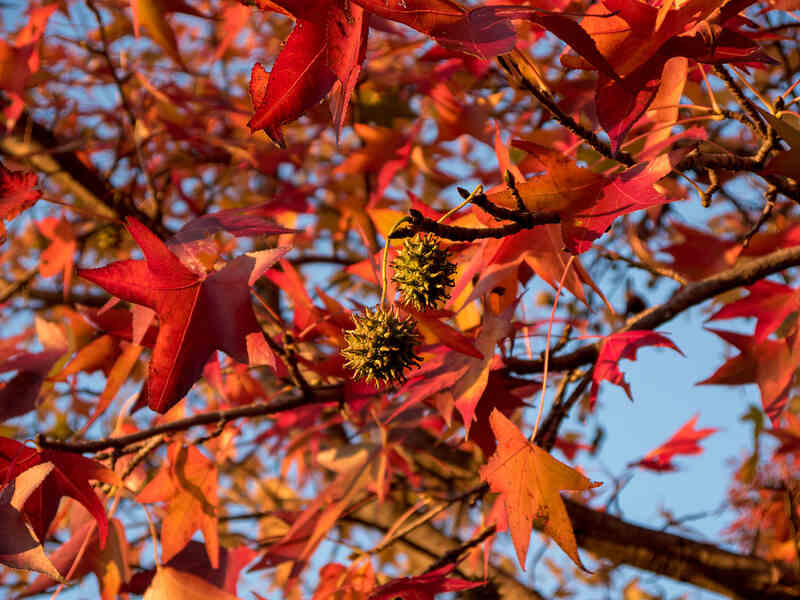
The famous sweetgum tree has a beautiful canopy that grows egg-shaped to pyramidal when young and broad-spread at maturity. You’ll love its foliage color, ranging from yellow to orange and purple in the fall.
As fruits, it produces spiky little balls that cover the ground most of the year. They look exciting but make maintenance difficult. You won’t be able to walk barefoot or even in sandals under its canopy. We don’t recommend planting a sweetgum tree near walkways.
- Botanical name: Liquidambar styraciflua
- Other common names: American storax, hazel pine, bilsted, edgum, satin-walnut, star-leaved gum
- Size at maturity: Grows 80 to 100 feet tall and 30 to 50 feet wide
- Growth rate: Moderate to fast, 2 to 3 feet per year, slower on dry soil
- Lifespan: Up to 400 years old
- Soil and water requirements: It prefers moist, rich, acidic soils and has moderate drought tolerance
- Light requirements: Full exposure to morning light with some protection from the strong afternoon sun
- USDA hardiness zone: Hardy to zones 6 to 8
13. Tulip Poplar
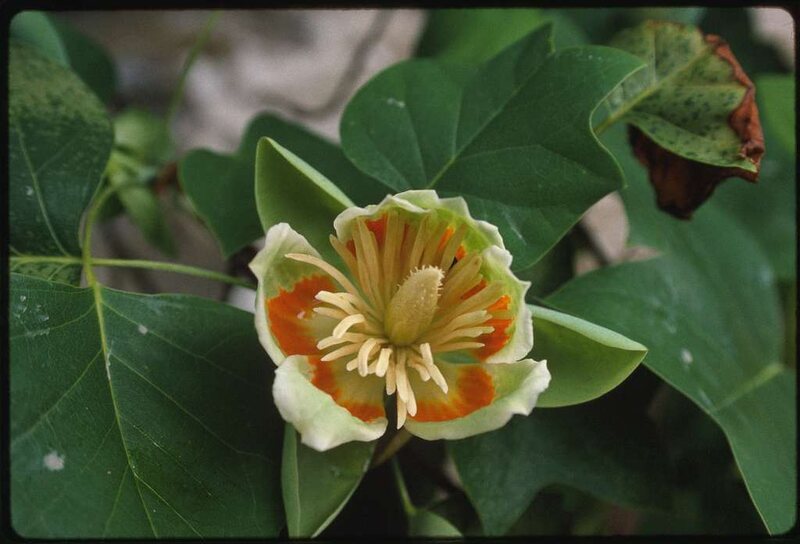
Also known as the tulip tree, the tulip poplar is the state tree of Kentucky, Tennessee, and Indiana, but also thrives in Atlanta’s gardens and parks. Actually, one of the tallest trees in Atlanta, reaching more than 166 feet tall, is a tulip poplar.
This ornamental tree is a member of the magnolia family and has cup-shaped flowers resembling tulips. They bloom from May to June into a splendid greenish-yellow, with a unique orange band at the petal base.
Its leaves also put on a show during fall when they turn golden-yellow and seem to help the sunlight shine stronger.
- Botanical name: Liriodendron tulipifera
- Other common names: Tulip tree, blue poplar, tulip poplar, yellow poplar, and yellow wood
- Size at maturity: Grows 60 to 120 feet tall and 30 to 60 feet wide
- Growth rate: Fast, 2 to 3 feet per year
- Lifespan: More than 200 years
- Soil and water requirements: Thrives in moist, organically rich, well-drained soils. Requires moderate watering. Clay soils have to be amended before planting.
- Light requirements: Full sun
- USDA hardiness: Hardy to zones 4 to 9
14. Black Tupelo

With medium-gray bark looking like an alligator hide and an oval crown, the black tupelo is an attractive native tree to add to your garden. Its leaves are a beautiful, glossy dark green during summer.
When fall comes, the black tupelo canopy gains fantastic shades of yellow, orange, red, scarlet, and purple, often on the same branch. Tupelo is a slow grower, needs full sun, and yields small, bluish-black fruits loved by many birds that will visit your yard.
- Botanical name: Nyssa sylvatica
- Other common names: Sorghum, pepperidge, tupelo, and tupelo gum
- Size at maturity: It grows 30 to 50 feet in height and spreads 20 to 30 feet wide.
- Growth rate: Slow to medium (less than 1 foot to 2 feet per year)
- Lifespan: Lives 100 to 200 years
- Soil and water requirements: Black tupelo grows in acidic, moist, rich, well-drained soils.
- Light requirements: Full sun or partial shade
- USDA hardiness zone: Hardy to zones 4 to 9
FAQ
There are many beautiful trees you can plant on a Georgia property. Among the most popular are:
• Southern live oak
• Sweet gum
• Dogwood
• Southern magnolia
• Crape myrtle
• Tulip poplar
• Tupelo
• Trident maple
• Japanese maple
The most common tree in Atlanta is considered to be the loblolly pine. It grows natively in degraded, abandoned fields, not sensitive to soil and moisture. Adaptable and fast-growing, the loblolly pine is easy to cultivate for timber.
The tree that owns itself in Athens, about 70 miles northeast of downtown Atlanta, is an oak tree. It’s located at the corner of South Finley and Dearing Streets and has legal ownership of all land within eight feet!
Adding trees to your landscape can affect your lawn care regimen in many ways: the shade from a tree can keep some grass from growing, fallen leaves and other debris can smother the grass, and trees tend to soak up a lot of the water in your soil.
To keep your grass healthy alongside a new tree, you must know exactly how to take care of it. Our seasonal lawn care guide for Atlanta will walk you through everything you need to know.
Choose the Best Tree for Your Atlanta Garden Today
The mild Atlanta climate favors many handsome trees with delicious fruits or unique flowers and foliage. It can be hard to choose just one. Remember that most Atlanta trees live for up to a hundred years, so this is a decision for life. The best way to go is to ask a pro. Find a talented landscaping team in the Metro Atlanta area and choose the best tree for your garden today!
Main Photo by: Famartin / Wikimedia Commons / CC BY-SA 4.0
